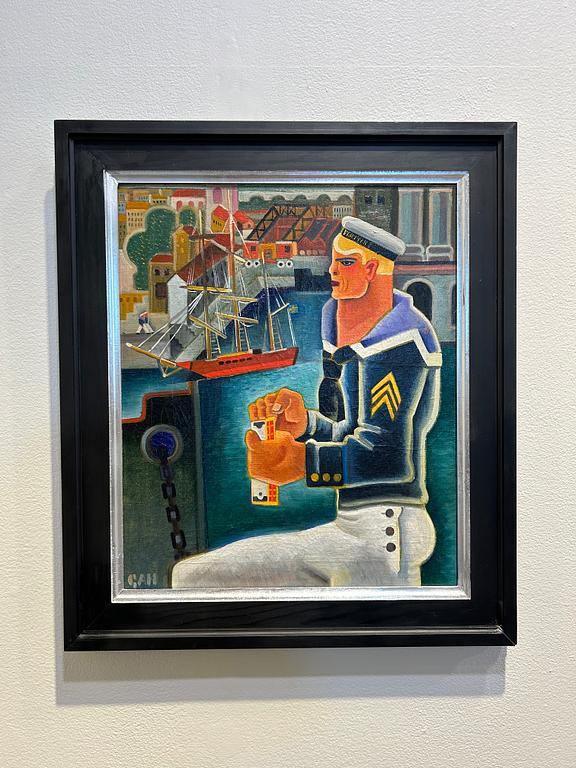Gösta Adrian-Nilsson
Swedish sailor
Signed GAN. Canvas 54 x 46 cm. Verso with dedication: "From Gösta to Jack 26/5/28. From Jack to Nils 11/9(?)/29. Canvas 54 x 46 cm.
Alkuperä - Provenienssi
Gift from Jack to Nils Ramselius, thence by descent within the family.
Muut tiedot
The strong attraction of sailors to GAN had three different reasons, intertwined with each other. The first and most important was the homoerotic attraction to 'the blues,' as he expressed in both his paintings and his diaries. The second reason was the geometry of sailors' uniforms, which fascinated the futuristic-cubist artist from Lund. The third reason lay more on the romantic plane: sailors represented for GAN adventure and the dream of distant exotic lands, of sailing out on the seven seas. When GAN lived in Gothenburg in the autumn of 1919, he made brave attempts to sign on to a boat bound for South America or the South Seas, and the dream of leaving behind the 'doomed' European civilization returned later as well.
But instead, it was Paris where he lived during the years 1920-1925 with interruptions for two longer stays in his homeland in 1922 and 1923. The first French artist GAN contacted was Fernand Léger, perhaps the most influential in the post-cubist avant-garde in Paris during the 1920s. Even before encountering (post)cubism in Paris, GAN had been moving towards a more unified and balanced cubism. The meeting with Léger stimulated him to continue down that path, but GAN never became – like so many others – an imitator of the admired French artist's painting. The synthetic cubism that GAN developed in Paris has a richer orchestrated palette and is far more detailed and personal. As the storyteller GAN fundamentally was, his cubist painting is also full of coded messages, a kind of sign language, which in disguised form often deals with his homosexuality and erotic attraction to sailors.
The great interest in sailors partly faded and was replaced by other motifs in the French capital. But now and then he painted, inspired by his encounters in the urban jungle, sailors in their uniforms. 'Swedish Sailor' fits into this context and thematically also connects to GAN's paintings from the 1920s.
The strikingly masculine sailor occupies half the motif with his muscular body where the large hands and the strong neck are dominant features. In the background, the clear blue water contrasts with the red ship with the city as a cubist silhouette. The painting is a personal tribute to the sailor, whom GAN also called the knight of the sea.
The model for 'Swedish Sailor' was named Jack and sat for GAN several times. According to the dedication on the back, GAN gave the auction painting to Jack in 1928, and the same year he passed it on to his good friend Nils Ramselius (1988-1958), a pastor within the Pentecostal movement. The work has been in the same family's ever since.







































































